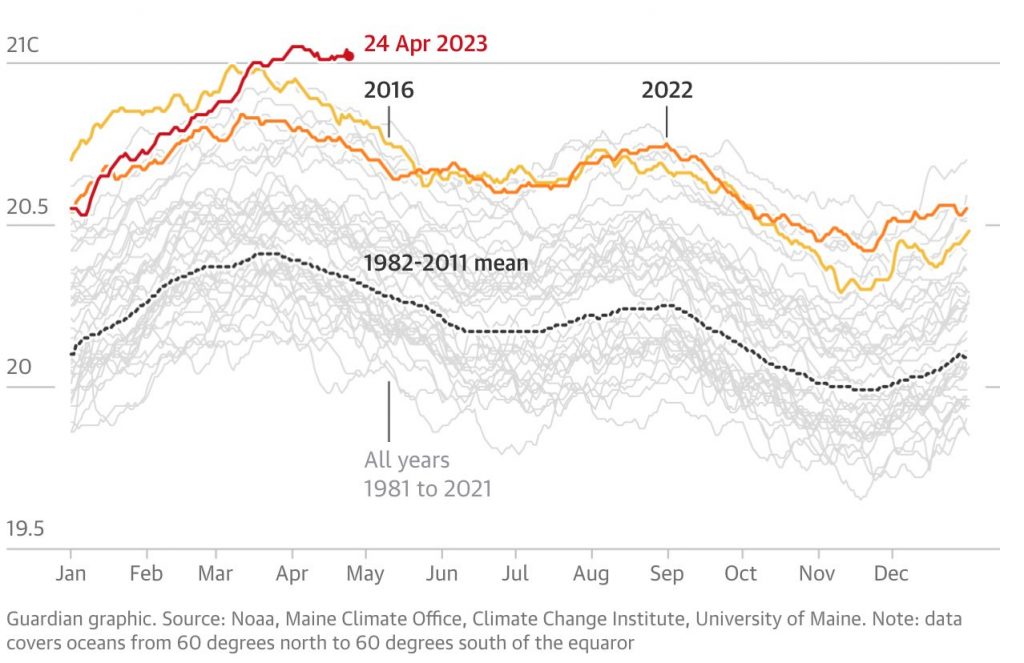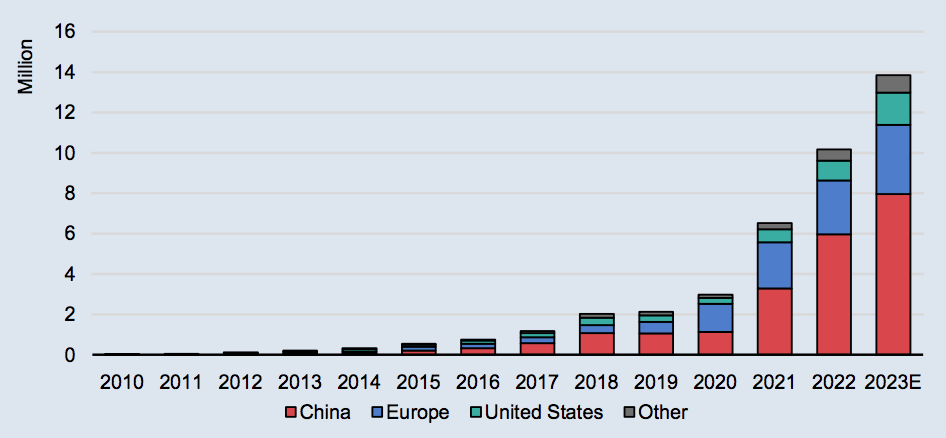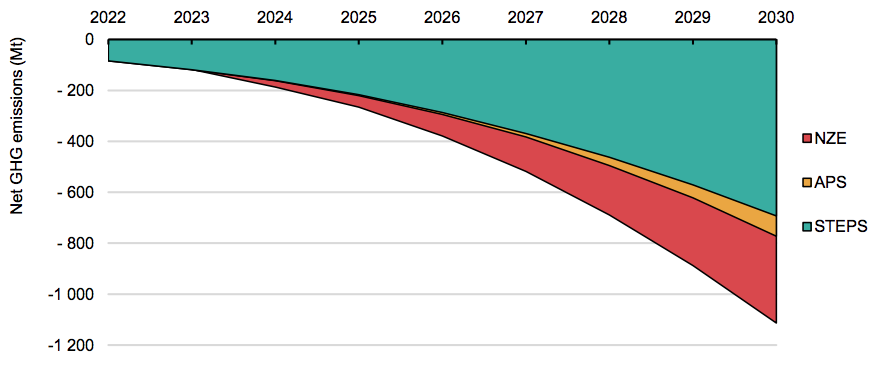https://www.valigiablu.it/crisi-climatica-shell-petrolio-gas-fine-era-combustibili-fossili/
- |
The weekly round-up on the climate crisis and data on carbon dioxide levels in the atmosphere.
That limiting the increase in global temperatures to within 1.5°C, as established in the 2015 Paris Agreement, is an impossible mission without the transition from fossil fuels to clean energy is certainly no longer news.It is a passage now taken for granted by studies and reports by panels of experts and scholars and it is information also acquired by governments.It is newsworthy, however, if it is an oil company that says it.
Last week Shell released the “Energy security scenarios”, a new series of scenarios in which the oil and gas company imagines how the global energy system could change over the course of the century.Between the lines of the report – observe Carbon Brief who analyzed the study in depth – it is clear that staying below 1.5°C means immediately putting an end to oil and gas growth.
This is certainly new considering that, in previous reports (the latest 2021), Shell foreshadowed – implausibly – oil and gas growth for another decade, even if global warming was limited to 1.5°C.
And even this new report is actually distant from what was stated by the analyzes conducted, for example, by the International Energy Agency (IEA) or by the Intergovernmental Panel on Climate Change (IPCC) of the United Nations.Although Shell's new scenarios are more in line with the conclusions of independent research, its 1.5°C temperature increase scenario still contains relatively high levels of fossil fuel use.If the world followed Shell's path, it would "breach" the 1.5°C limit for decades, before returning below that level by the end of the century using machines. high energy intensity, not yet experienced which are expected to suck large volumes of carbon dioxide (CO2) from the atmosphere.
In summary, Shell admits that it will not be possible to limit global warming and avoid the most devastating effects of the climate crisis without slowing down the growth of fossil fuels but at the same time we could continue to produce energy from fossil sources for a while longer, subsequently aspiring to carbon dioxide emitted into the atmosphere thanks to a new technology whose effectiveness, however, there are still conflicting opinions.
For the avoidance of doubt, the fossil fuel giant also emphasizes that its scenarios should not be construed as predictions, projections or business plans.Furthermore, Shell's new CEO, Wael Sawan, he said recently that “cutting oil and gas production is unhealthy.”
What Shell's new scenario predicts
“Sky 2050” is the latest scenario in the series that Shell opened in 2018 to outline pathways for reducing global emissions in line with the 1.5°C goal established under the Paris Agreement.
In 2018, the oil company foresaw an energy transition within a framework that predicted a rise in temperatures within 2°C.This scenario was followed, in 2021, by “Sky 1.5”, a more “ambitious” update that aimed to limit rising temperatures in line with the Paris Agreement by the end of the century.The scenario, however, maintained exactly the same fossil fuel use and long-term energy demand as the previous version, but offset by more plants.
The last scenario, “Sky 2050” was thus illustrated by Laszlo Varro, Shell's vice president for global business environment and former chief economist of the International Energy Agency (IEA), in a post on LinkedIn:
“In the completely reshaped Sky scenario, the fossil fuel-dominated system itself is seen as a security risk and society looks forward to an accelerated transition.At Sky, clean technology becomes like space technology during the Cold War, [with] fantastic technological achievements driven not by cooperation but by competition.”
Shell therefore seems to have recalibrated its hypotheses.While previous pathways viewed rapid growth in global energy demand as an unstoppable force of nature, the new scenario envisions much slower demand growth.And that would allow for a much faster reduction in fossil fuels.
In Shell's old scenarios, oil production would peak between 2025 and 2030.In the new scenario, oil production would have already reached its peak and then decline and stabilize by 2028, when it begins to decline rapidly, especially for European and North American companies operating in countries not belonging to the Organization of Exporting Countries. of Oil (OPEC).
In this scenario, OPEC oil producers use revenues from high fossil fuel prices to finance a shift away from dependence on oil and gas.Meanwhile, non-state and independent oil companies, such as Shell, take "a cautious approach" and "prefer to generate cash for their investors rather than invest in additional production capacity."As a result, OPEC captures a larger share of production.
The same goes for gas.Shell states that:“A key feature of the Sky 2050 scenario is that the ‘golden age of gas’ is coming to an end.”According to analysis by Carbon Brief, the new scenario reveals that gas production growth peaked just before the COVID-19 pandemic.
In the long term, the new scenario sees oil and gas consumption reduced by around two-thirds compared to the previous Sky 1.5°C path.However, Shell still sees a significant role for both fossil fuels until 2100.
The lower demand for energy is largely determined by an acceleration of the introduction of renewables, greater electrification of the energy system and faster energy efficiency of homes.The new scenario also significantly rescales the growth hypotheses of nuclear energy and bioenergy.
Compared to previous scenarios, less space is given to the role of afforestation.Shell's old 1.5°C scenario called for "broad deployment of nature-based solutions", including tree planting over an area approaching that of Brazil.The new scenario admits that this is an unrealistic hypothesis.
Finally, there is no shortage of still controversial solutions that are popular within the fossil fuel industry, despite not yet being tested on a large scale, such as the rapid growth of direct air capture (DAC) machines to remove CO2 from the atmosphere.
In addition to doubts about feasibility, DAC technology may require very high energy demands.In fact, in “Sky 2050” the DAC ends up consuming 13% of the world's energy supplies in 2100.This is more energy than is used to power every road vehicle, every airplane or every home in the world.
Record ocean temperatures are taking Earth into 'uncharted territory'
Temperatures in the world's oceans have hit new highs for more than a month, which several experts say is taking the Earth into "uncharted territory" in the climate crisis.
Data collected by the United States National Oceanic and Atmospheric Administration (NOAA). they detected continuously temperatures never reached since they were collected since 1981, at a time of year when ocean temperatures are normally falling compared to the annual peaks of March and April.Varying slightly from day to day, they have not dropped below 21°C for at least 45 consecutive days.This is an anomaly for which climate scientists are struggling to find an answer.“It's a real surprise and very worrying.This could be a short-lived extreme spike, or it could be the start of something much more serious,” he commented the prof.Mike Meredith of the British Antarctic Survey.

Ocean warming is concerning for many reasons.Sea water takes up more space at higher temperatures, accelerating sea level rise, and warmer water at the poles accelerates the melting of ice caps.Higher temperatures can also be disastrous for marine ecosystems.Corals, in particular, can suffer devastating bleaching.
According to a study by the Universities of Exeter and Cardiff, published in the magazine Nature Communications on April 27, the “twilight zone” of the oceans, between 200 and 1,000 meters deep, which receives little light but is home to a wide variety of organisms and billions of tons of organic matter, is particularly vulnerable to warming:Climate change is on track to cause a 20-40% reduction in marine life in the twilight zone by the end of this century.
Some scientists worry that the rapid warming could be a sign that the climate crisis is progressing faster than expected.In recent decades the oceans have acted as a sort of global buffer against the climate crisis, both by absorbing large quantities of carbon dioxide that we have released into the atmosphere, both storing approximately 90% of the energy and excess heat that has been created.Are we reaching the limit of the oceans' absorption capacity?According to prof.Meredith is still too early to reach any conclusions.
International Energy Agency (IEA):in 2023 one in five cars will be electric
According to the new Global EV Outlook report of the International Energy Agency (IEA), there will be "explosive" growth in the electric car market and by 2030 more than one in three new vehicles will be electric.More than double the forecasts of just two years ago, above all thanks to the new growth policies in the United States andEuropean Union.Which translates into a cut in annual emissions equivalent to the entire German economy and a 5% decrease - again by 2030 - in oil demand (five million barrels per day).Already by 2023, the IEA predicts that one in five new cars will be electric.However, adds the IEA, the concomitant expansion of SUVs, large vehicles with high energy consumption, has almost canceled out the reduction in emissions resulting from record sales of electric cars.
The role of electric cars in the fight against climate change
In fact, in 2022, a decrease in global emissions of 80 million tonnes of CO2 equivalent (MtCO2e) was recorded thanks to the sale of over 10 million electric cars.By the end of this year, 14 million sales should be reached, equal to 18% of the total, an increase of 4% compared to 14% in 2022 and 1% in 2017.
60% of global sales took place in China, where already in 2022 one in three cars sold was electric.

In addition to China, the IEA reports, as mentioned, the new policies adopted on the matter by the United States and the European Union which, together, have led to an upward revision of the forecasts of recent years.
If governments reached the targets they have set for both electric vehicles and clean energy production, 770 MtCO2e of emissions would be avoided, continues the IEA.In this scenario, called the Announced Commitments Scenario (APS), nations would be about two-thirds of the way towards net zero emissions by 2050 (NZE).To close the remaining gap, governments should accelerate the decarbonization of trucks and buses, in particular, which would lead to a 25% drop in emissions.

However, the report notes that the increase in sales of SUVs, including electric ones, will need to be taken into account.In addition to emissions from driving, in fact, "it will also be important to mitigate the impacts of larger batteries".The report finds that the larger quantities of minerals needed to build SUV batteries can result in CO2 emissions from processing and manufacturing that are more than 70% higher than regular electric car batteries.
Climate change has made Horn of Africa drought 100 times more likely
There worst drought in forty years It has caused crop failure, animal death in the Horn of Africa and left more than 4 million people in need of humanitarian assistance and 20 million at risk of food insecurity.In 2022, 942,000 children aged between six months and five years suffered from acute malnutrition in Kenya alone.In Kenya, Ethiopia and Somalia, 3.3 million people they had to abandon their homes.According to a study by the group World Weather Attribution, Without human-caused climate change, the drought that hit southern Ethiopia, southern Somalia and eastern Kenya in 2021 would not have occurred.The climate crisis has made the devastating scale of this drought approximately 100 times more likely.
The intensity and likelihood of the African drought was due “principally” to evaporation of water from soil and plants, which increased “significantly” due to higher-than-normal temperatures.
“Frequent multi-year droughts will have a serious impact on the food security and health of people in the Horn of Africa as the climate continues to warm,” he commented Joyce Kimutai, a climate scientist at the Kenya Meteorological Department and author of the study.While people in the region are “no strangers to drought,” the length of the 2021 drought “has pushed people beyond their ability to cope,” added Cheikh Kane, climate resilience policy advisor at the Center for Climate Change. climate of the Red Cross and another author of the report.
The researchers analyzed weather data and computer model simulations to compare today's climate with that of the pre-industrial era, before the world warmed by about 1.1 C.Despite recent heavy rains and flash floods in the Horn of Africa, NASA's Earth Observatory he warned in March that the drought situation will “likely continue” and will not be stopped by this year's wet weather.
The expansion of cultivated land into protected areas threatens biodiversity conservation goals
The latest United Nations Conference on Biodiversity in Montreal, Canada, ended with an agreement, awaited for years, which plans to protect 30% of land and sea (30 by 30) by 2030.Respecting this objective will, however, be "challenging" if cultivated land continues to expand in protected areas recorded rhythms between 2000 and 2019, detect a study published in Nature Sustainability.
In the world There are more than 260,000 protected areas, including national parks, forests and nature reserves. According to the International Union for Conservation of Nature, these areas are an “important tool” for storing carbon, safeguarding biodiversity and reducing climate-related risks.According to the Protected Planet report from March 2023, just over 17% of the world's lands and inland waters are currently protected and conserved areas.
Previous research they estimated that 6% of global protected areas are used for crops.To understand how these areas are changing over time, the new study uses satellite imagery to remotely assess the extent of cultivation expansion in protected areas around the world.Three data sets (covering different time periods to assess the extent of this expansion) were used as a reference, showing how the annual rate of cropland expansion has grown 58-fold in almost two decades.That is represents a “major potential threat to biodiversity conservation” and, without changes in crucial protected areas, the global land conservation target for 2030 “will not be achieved”.
A group of researchers from the University of Oxford involved 250 students to monitor the commitments of states and companies to reduce emissions
The Tracker consortium, born from a joint project between the Energy and Climate Intelligence Unit and Oxford Net Zero, an interdisciplinary group of researchers from the University of Oxford (with the contribution of the Data Driven EnviroLab of the University of North Carolina Chapel Hill and the non-profit research NewClimate Institute), involved 250 students in the creation of Net Zero Tracker, a platform that collects data and evaluates the climate commitments of States and companies for real and timely decarbonisation.
The volunteers range from freshmen to final year PhD students, come from different educational backgrounds, from physical climate sciences to English literature and receive training in entering and monitoring data to be inserted on the platform.“Volunteers collaborate in 'code-a-thons' in person, or from home, to dissect an ocean of publicly available data, including analysis of the strength of targets that 200 countries and 2,000 of the largest publicly traded companies in purse of the world they gave themselves", explains Camilla Hyslop in an article on Times Higher Education.More than 50,000 individual data points have been created so far.
“The most common feedback from volunteers is that their knowledge about net zero emissions increases significantly, as does their research skills,” notes Hyslop.“Plus, volunteers feel that sense of fulfillment that comes from personal action.Some volunteers have even considered changing the direction of their studies or careers after volunteering with us.In the near future we will introduce a certification system to recognize their work.This should open doors for them in the future, given the growing demand for literacy net-zero”.

Preview image: Pxhere.com - Free of Copyrights (Creative Commons CC0)

